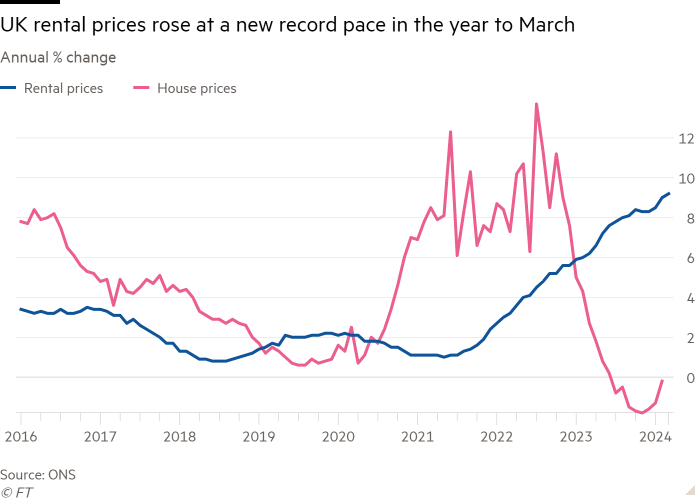Stay informed with free updates
Simply sign up to the UK property myFT Digest — delivered directly to your inbox.
UK rents rose at a record pace of 9.2 per cent last month while house prices stagnated, with London hit hardest, as higher borrowing costs continued to squeeze both landlords and tenants.
The jump in average private rents in the year to March marked the biggest annual percentage change since the Office for National Statistics began collecting data in 2015. It compared with a rise of 9 per cent in the 12 months to February.
House prices dipped 0.2 per cent in the year to February, better than the 1.3 per cent fall in January, putting the average cost of a property at £281,000.
Wednesday’s figures identified London as the region with the most expensive rents, at an average of more than £2,000 a month, and the fastest rent rises, at 11.2 per cent a year. In Great Britain overall, the average monthly rent stood at £1,200.
The ONS figures cover the entire stock of privately rented properties, which means they lag prices for new-let agreements, and separate data has indicated that the rental market is now cooling.
But the 9.2 per cent rise highlighted how increased financing costs have hit tenants, because of landlords withdrawing properties from the market or passing on the cost of higher mortgage payments.

Elevated mortgage rates have made it difficult for many people to buy a property, adding to rental demand.
Katy Eatenton, mortgage and protection specialist at financial services group Lifetime Wealth Management, said the data highlighted “the immense pressure tenants are under. Rising mortgage rates have meant many landlords have had no choice but to increase rents.”
Mortgage rates have declined from their peak last summer but they remain much higher than they were two years ago, reflecting the Bank of England’s decision to raise interest rates to a 16-year high of 5.25 per cent in a bid to tame inflation.
Financial markets expect the BoE to cut rates this year, but traders have revised down the prospect of lower borrowing costs since the start of 2024 over concerns about sticky underlying price pressures.
Official data published on Wednesday showed headline inflation slowed less than expected to 3.2 per cent in March.
The average house price was about £4,000 below its peak in November 2022, according to the ONS, reflecting the impact of higher interest rates.
Still, the average property cost about £50,000 more than it did in January 2020, in a sign of the impact of the “race for space” at the start of the pandemic, when interest rates stood at a record low of 0.1 per cent.
The ONS reported large variations in house prices across different parts of the country. While London was the worst performer, registering a 4.8 per cent annual contraction, Scotland was the best, recording a rise of 5.6 per cent.
Jake Finney, economist at consultancy PwC UK, said that the softer decline in house prices in February compared with January could signal “that we are approaching the end of the housing market correction”.












